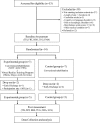Canoe game-based virtual reality training to improve trunk postural stability, balance, and upper limb motor function in subacute stroke patients: a randomized controlled pilot study
- PMID: 27512255
- PMCID: PMC4968497
- DOI: 10.1589/jpts.28.2019
Canoe game-based virtual reality training to improve trunk postural stability, balance, and upper limb motor function in subacute stroke patients: a randomized controlled pilot study
Abstract
[Purpose] This study was aimed at investigating the preliminary therapeutic efficacy and usefulness of canoe game-based virtual reality training for stroke patients. [Subjects and Methods] Ten stroke patients were randomly assigned to an experimental group (EG; n=5) or a control group (CG; n=5). Patients in both groups participated in a conventional rehabilitation program, but those in the EG additionally participated in a 30-min canoe game-based virtual reality training program 3 days a week for 4 weeks. Therapeutic efficacy was assessed based on trunk postural stability, balance, and upper limb motor function. In addition, the usefulness of canoe game-based virtual reality training was assessed in the EG and therapist group (TG; n=20), which consisted of physical and occupational therapists, by using the System Usability Scale (SUS). [Results] Improvements in trunk postural stability, balance, and upper limb motor function were observed in the EG and CG, but were greater in the EG. The mean SUS scores in the EG and TG were 71 ± 5.2 and 74.2 ± 4.8, respectively. [Conclusion] Canoe game-based virtual reality training is an acceptable and effective intervention for improving trunk postural stability, balance, and upper limb motor function in stroke patients.
Keywords: Postural balance; Stroke; Virtual reality exposure therapy.
Figures
Similar articles
-
Game-Based Virtual Reality Canoe Paddling Training to Improve Postural Balance and Upper Extremity Function: A Preliminary Randomized Controlled Study of 30 Patients with Subacute Stroke.Med Sci Monit. 2018 Apr 27;24:2590-2598. doi: 10.12659/MSM.906451. Med Sci Monit. 2018. PMID: 29702630 Free PMC article. Clinical Trial.
-
The effect of virtual reality-based balance training on motor learning and postural control in healthy adults: a randomized preliminary study.Biomed Eng Online. 2018 Sep 18;17(1):124. doi: 10.1186/s12938-018-0550-0. Biomed Eng Online. 2018. PMID: 30227884 Free PMC article. Clinical Trial.
-
Virtual Reality in Upper Extremity Rehabilitation of Stroke Patients: A Randomized Controlled Trial.J Stroke Cerebrovasc Dis. 2018 Dec;27(12):3473-3478. doi: 10.1016/j.jstrokecerebrovasdis.2018.08.007. Epub 2018 Sep 5. J Stroke Cerebrovasc Dis. 2018. PMID: 30193810 Clinical Trial.
-
Virtual reality for stroke rehabilitation: an abridged version of a Cochrane review.Eur J Phys Rehabil Med. 2015 Aug;51(4):497-506. Epub 2015 Jul 9. Eur J Phys Rehabil Med. 2015. PMID: 26158918 Review.
-
Effects of Virtual Reality Compared to Conventional Therapy on Balance Poststroke: A Systematic Review and Meta-Analysis.J Stroke Cerebrovasc Dis. 2019 Jul;28(7):1787-1798. doi: 10.1016/j.jstrokecerebrovasdis.2019.03.054. Epub 2019 Apr 25. J Stroke Cerebrovasc Dis. 2019. PMID: 31031145
Cited by
-
Virtual reality for stroke rehabilitation.Cochrane Database Syst Rev. 2017 Nov 20;11(11):CD008349. doi: 10.1002/14651858.CD008349.pub4. Cochrane Database Syst Rev. 2017. Update in: Cochrane Database Syst Rev. 2025 Jun 20;6:CD008349. doi: 10.1002/14651858.CD008349.pub5. PMID: 29156493 Free PMC article. Updated.
-
Trunk training following stroke.Cochrane Database Syst Rev. 2023 Mar 2;3(3):CD013712. doi: 10.1002/14651858.CD013712.pub2. Cochrane Database Syst Rev. 2023. PMID: 36864008 Free PMC article. Review.
-
A Game Changer: 'The Use of Digital Technologies in the Management of Upper Limb Rehabilitation'.Adv Exp Med Biol. 2019;1205:117-147. doi: 10.1007/978-3-030-31904-5_9. Adv Exp Med Biol. 2019. PMID: 31894574
-
The Use of Armeo®Spring Device to Assess the Effect of Trunk Stabilization Exercises on the Functional Capabilities of the Upper Limb-An Observational Study of Patients after Stroke.Sensors (Basel). 2022 Jun 8;22(12):4336. doi: 10.3390/s22124336. Sensors (Basel). 2022. PMID: 35746117 Free PMC article. Clinical Trial.
-
Effect of different modalities of artificial intelligence rehabilitation techniques on patients with upper limb dysfunction after stroke-A network meta-analysis of randomized controlled trials.Front Neurol. 2023 Apr 17;14:1125172. doi: 10.3389/fneur.2023.1125172. eCollection 2023. Front Neurol. 2023. PMID: 37139055 Free PMC article.
References
-
- Cuthbert JP, Staniszewski K, Hays K, et al. : Virtual reality-based therapy for the treatment of balance deficits in patients receiving inpatient rehabilitation for traumatic brain injury. Brain Inj, 2014, 28: 181–188. - PubMed
-
- McEwen D, Taillon-Hobson A, Bilodeau M, et al. : Virtual reality exercise improves mobility after stroke: an inpatient randomized controlled trial. Stroke, 2014, 45: 1853–1855. - PubMed
-
- Brumels KA, Blasius T, Cortright T, et al. : Comparison of efficacy between traditional and video game based balance programs. Clin Kinesiology, 2008, 62: 26–31.
-
- Taylor MJ, McCormick D, Shawis T, et al. : Activity-promoting gaming systems in exercise and rehabilitation. J Rehabil Res Dev, 2011, 48: 1171–1186. - PubMed
-
- Mouawad MR, Doust CG, Max MD, et al. : Wii-based movement therapy to promote improved upper extremity function post-stroke: a pilot study. J Rehabil Med, 2011, 43: 527–533. - PubMed
LinkOut - more resources
Full Text Sources
Other Literature Sources
Medical
Miscellaneous

